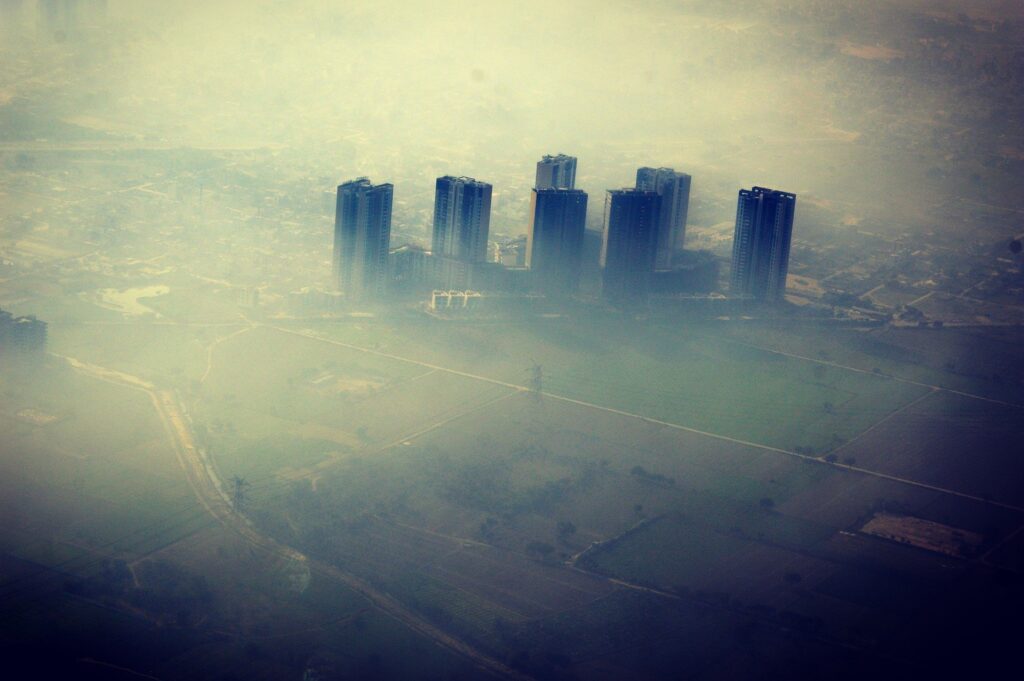As per WHO, more than 4.2 million deaths occur every year due to outdoor air pollution alone.
With the increase in development and growth of the urban population, Delhi has witnessed a significant rise in the demand for transportation, construction, and energy. Simultaneously, a rise in serious environmental conditions like poor AQI (Air Quality Index) has become a major concern in the past few decades.
Delhi, the capital of India and one of the largest megacities in the world, is known for its infamous winter when the air quality deteriorates drastically due to several factors like vehicle emissions, secondary particles (pollutants which form in the atmosphere e.g. smog), biomass and solid waste combustion, construction materials, dust, etc. The latter sources then produce pollutants such as sulfur dioxide (SO2), nitrogen oxides (NOx), carbon monoxide (CO) ozone (O3), and particulate matter (PM).
Particulate matter can be primarily classified into two types: one with PM below 10μm (PM10) and the other with PM below 2.5μm (PM2.5). PM2.5 is considered to be the most critical to human health as its chemical composition has contributions from all the other detrimental pollutants. It has also been recorded that PM2.5 is one of the most crucial pollutants in the case of Delhi. In the year 2019, the average annual PM 2.5 concentration for Delhi was found to be 98.6 µg/m3 whereas the average annual PM 2.5 concentration across India was 58.1 µg/m3 (WHO target = 0-10 µg/m3).
Furthermore, according to the World Air Quality Report 2020, compiled by IQAir 35 out of the world’s top 50 most PM2.5 polluted cities are in India, and Gaziabad (a part of the National Capital Region of Delhi) was ranked 2nd with an average of 106.6 µg/m3! Having said that, it has also been recorded that India is reporting a considerable improvement in reducing the PM2.5 concentration which can also be seen in the graph below.
Located in a semi-arid climate zone, Delhi typically has three seasons – the summers are usually long (April to October), monsoon falls in between, and winters from October to January. The air pollution during winters is however recorded to be 2-3 times the pollution level in summer causing inconvenience in transportation, flight delays, and accidents and not to mention the adverse health effects.
This rise in AQI during the winters is mainly due to two reasons: biomass combustion for purposes such as heating or Crop Residue Burning (a common traditional practice in the outskirts of Delhi) and meteorology. Due to the unfavorable change in the wind directions and lower boundary layer heights in the atmosphere, poor ventilation with weak pollutant dispersion can be seen thus leading to an increase in air pollution. The latter sentence is further justified by the figure given below.
For the past few decades, the government has taken ample steps to enhance the living standard and keep pollution in check. Some of the most notable initiatives were the fuel switch of all public transport and private taxis from diesel to compressed natural gas (CNG), odd-even car number plate scheme, conversion of coal-based thermal power plants to gas-based power plants, and relocation of coal and fuel-oil industries and brick kilns to the city outskirts.
Although, these solutions were successful in bringing down the AQI, the rise in growing sources of air pollution was recorded to substantially outnumber the success of all the initiatives taken; therefore creating a bigger challenge for the city administration. Contemplating the seriousness of the situation, in November 2020, the Union Minister of Environment, Forest and Climate Change inaugurated compressed biogas (CBG) demonstration plant in Pune.
Anaerobic fermentation of biomass is gaining rapid fame due to its simultaneous waste management and energy production. Many enunciate that the climate, biomass availability, and hands-on operations available in India are encouraging for biomass generation and utilization.
CBG is an initiative to establish a permanent solution to the growing AQI in the Northern regions of India, especially during the winters. As seen in the latter figure, vehicular emissions and biomass burning are the topmost reasons for the deteriorating Delhi AQI during winters. The government aims to address both the sources through a sustainable approach via CBG.
CBG or compressed biogas is a green technology that broadly involves two steps. The process starts with anaerobic decomposing of biomass (crop residue or stubbles in this case) thereby producing biogas. Biogas is a mixture of gases primarily composed of methane (CH4) and carbon dioxide (CO2). The second step involves compressing biogas to remove carbon dioxide and therefore producing compressed biogas or CBG. Bringing CBG into practice, the government not only plans on addressing the rising stubble-burning incidents but also aims on promoting sustainable transport by switching to CBG as a fuel choice.
Hence, it is evident that CBG plants will not only help lower the AQI but also reduce India’s dependency on fuel import/ non-renewable resources, therefore, making CBG a win-win situation.




Very good article. I certainly appreciate this website. Keep writing!